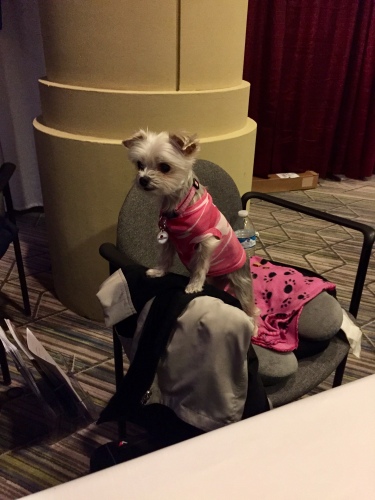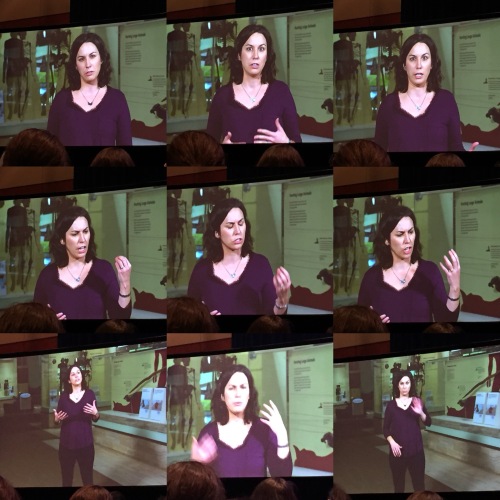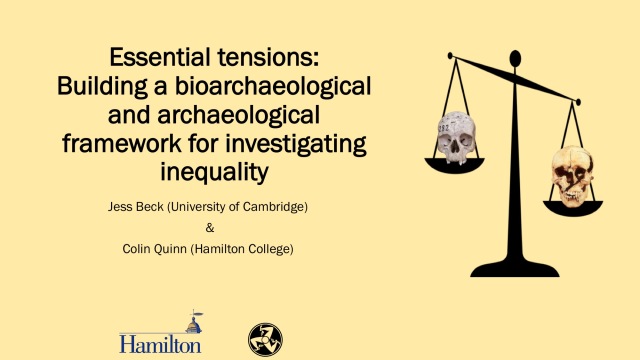I moved to the UK at the beginning of October, so it no doubt seems strange that I scheduled a trip abroad less than two months later. However, the quick turnaround was for a worthwhile anthropological cause: in late November I headed back to the US to attend my first “triple As”.
The AAA meetings – the conference run by the American Anthropological Association – occur once a year in the late fall. They are the major US meetings for both sociocultural anthropologists and linguistic anthropologists, with attendance running to 6,000+. As such they’re much larger than the primary American conference for biological anthropology (the AAPA meetings), or the Society for American Archaeology meetings, which are larger but still not quite so overwhelming.

Because these meetings are traditionally attended by cultural and linguistic anthropologists, they have become a far more intimate scholastic setting for networking if you are an archaeologist or biological anthropologist. In 2017, I joined as a member of the Biological Anthropology Section upon the recommendation of friends and colleagues, since there are a number of highly active biological anthropologists who have been trying to make the conference more four-field friendly. One example of this is an excellent session I attended that was co-organized and co-chaired by my close friend Caroline VanSickle (NEPOTISM ALERT #1). The session was titled “Biological Anthropology and the Public”, and each of the presenters was invited to speak because they conduct their own unique form of public outreach. This session was particularly innovative because each of the 10-15 minute presentations were filmed in advance at the Smithsonian NMNH , and the videos were broadcast for the first time at the conference session itself a few days later. Sue Sheridan (@SusanGSheridan) discussed the perils and pitfalls of running popular Facebook group BioAnthropology News. Kate Clancy (@KateClancy) followed up by describing how her Period Podcast allows her to reach a much broader audience than her previous attempts at scientific blogging, while Julie Lesnik (@JulieLesnik) gave the audience a series of patented “Tips and Tricks” for making science lectures resonate with broader public audiences.
Sue Sheridan (@SusanGSheridan) discussed the perils and pitfalls of running popular Facebook group BioAnthropology News. Kate Clancy (@KateClancy) followed up by describing how her Period Podcast allows her to reach a much broader audience than her previous attempts at scientific blogging, while Julie Lesnik (@JulieLesnik) gave the audience a series of patented “Tips and Tricks” for making science lectures resonate with broader public audiences.
After Julie, Becca Peixoto (@Becca Peixoto) talked about what it felt like to livestream her work as an ‘underground astronaut’on the Homo naledi project into classrooms and lecture halls around the world. Natalia Reagan (@natalia13reagan), dressed in my favorite conference outfit to date, recounted her time spent debating and debunking popular cryptozoological myths (among others), from an anthropological perspective, and Briana Pobiner rounded out the session by describing how museums can incorporate and promote scientific outreach.
Agustín Fuentes (@Anthrofuentes) led the subsequent discussion, which touched upon important topics ranging from the undervaluation of outreach in tenure decisions to the unfortunate reality of being a woman on the internet in 2017, including death threats and rape threats. Andre Costopoulos, a mentor of mine when I was an undergraduate at McGill University (NEPOTISM ALERT #2), has written an excellent follow-up piece inspired by the session that delves into the historical backdrop to the shift in anthropological attitudes towards public outreach.
I was in the audience for the entire session, and have recapped it as a Twitter moment. Grudgingly, I have to admit that the talks themselves are even more engaging than my tweets, and they are all available to watch on the BOAS Network YouTube channel. These are worth a watch. This session ranks as one of the most innovative conference presentations I’ve seen in anthropology, up there with the “UpGoer Five” session at the 2017 AAPAs in New Orleans, and of course Alison Atkin’s most excellent conference poster “The Attritional Mortality Myth” (also known as #plagueposter).
The session in which I myself presented, titled “Bioarchaeology and the Biocultural Synthesis: Current Perspectives and Applications,” was organized by Michigan State University PhD student Lisa Bright and Idaho State University visiting assistant professor Amy Michael, and focused on biocultural approaches to bioarchaeology. The session abstract emphasized employing “biocultural models that blend social theory with cultural, environmental, and biological interactions,” and was aimed at “researchers whose work encompasses issues that were relevant in the past just as today (e.g. migration and immigration, gender and sexuality, race and ancestry, privilege, economics, and health).” There were some great talks in that vein, from discussions of how structural violence affected historic populations in the United States, to the impact of race and gender in the both the ancient past and in the present.
I presented a co-authored paper on the ways in which mortuary archaeology and bioarchaeology provide complementary lines of cultural and biological evidence that can be used to more fully understand the emergence of inequality in human societies. We drew upon case studies from Copper Age Iberia, Early Bronze Age Romania, and Bronze Age Ireland to illustrate the ways that our approach can inform the emergence of inequality in different parts of the world in prehistory. That paper, co-authored with the esteemed Colin Quinn, was published in Open Archaeology in 2016 as a paper titled “Essential Tensions: A Framework for Exploring Inequality Through Mortuary Archaeology and Bioarchaeology.” One of our goals over the past two years has been to break the Top 5 most downloaded articles list for that journal, so go ahead and give it a read if you’re feeling generous.
Since I was able to participate in a thought-provoking series of bioarchaeology presentations and witness a stellar session on public outreach in biological anthropology, I’d say my first AAAs were a success. However, I still haven’t recounted the most important interaction of my conference experience: meeting the world’s most compelling graduate school recruiter (spotted at the booth for KSU).

More Washington DC conference shenanigans to unfold in 2018, as I’ll be back in the city in the spring to present a poster and a paper at the Society for American Archaeology meetings. Until then, Happy (almost) New Year!









Pingback: Bone Broke Year in Review 2017 | Bone Broke